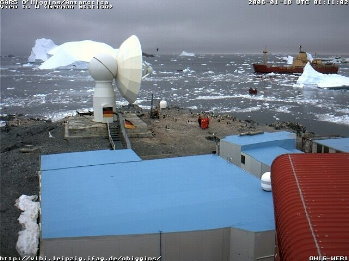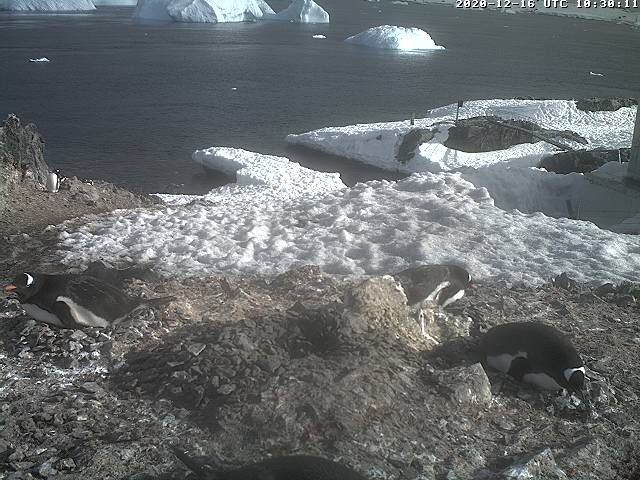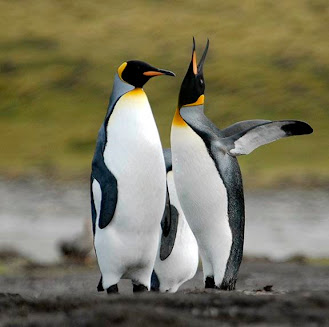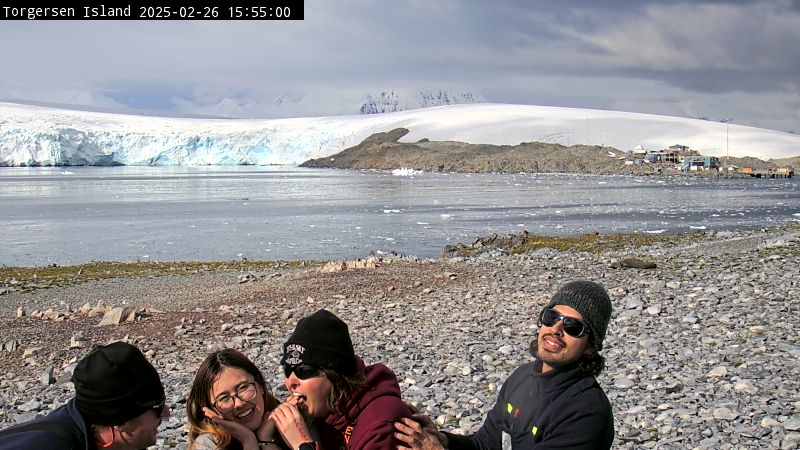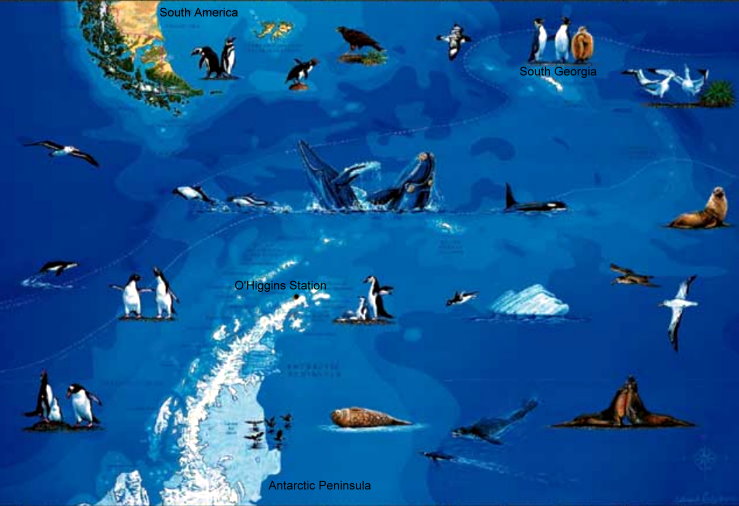



Be sure to say "hi" to Jen at http://pengcognito.com/
:P

This blog follows the breeding season of Gentoo penguins at the Gars O'Higgins research facility, as well as the King, Adelie, and Gentoo penguins at South Georgia Island. This blog will consist of images taken from the nesting site at O'Higgins Station, the surrounding area on the Antarctic Peninsula, and the beach on South Georgia Island.



What a wait it's been, but it's finally here. Today, for the first time this year, newly hatched chicks were popping up and out all around the rookery. Take a look....
JC's neighbor flaunted her chick while RM took a good look at his own nest and JC.
Then... on the other side of our waiting parents, there was a chick. The first one, demanding his or her dinner.
But then, up from the nest a parent rises and there it is. The hole where the egg tooth protrudes ever so slightly. Our chicks are on the way.
Within the next 24 hours, there should be hatching en masse... not to be missed. And our good parents to be should be showing them off.
More tomorrow, as the day unfolds.

Posted by
wiinterrr
at
10:38 PM
0
comments
![]()
 Christmas Eve approaches and the eggs should begin to hatch around that date!
Christmas Eve approaches and the eggs should begin to hatch around that date!
What an exciting week it has been! The sea ice is melting under the Summer Solstice sun (Io Saturnalia!) and the Gentoos seem to getting nicely round in form. Idyllic scenes have been the norm, what with parents swapping nest duty; also, the scavenger birds, so far, are staying away.


But what else has been happening? This picture says it all. Two days ago, we had some premature excitement: the eggs began to move and parents were constantly inspecting the shells for cracks and the appearance of an egg tooth.
Notice the peeking and inspecting. All eyes are on those eggs.
Every grab I made of the community at large showed, at least, one of the birds checking the nest.


This one is so sweet. It's like Mom or Dad are asking their new chicks, "Are we there yet?"
That is a very concerned look for a parent-to-be and one that caused myself to also be alert.
So funny! A parent stands and shows off the "pantaloon" look. Also, two days ago, there was a "heat wave" on the Antarctic peninsula: 34 degrees F., and all the natives were restless.
And as for South Georgia Island, the seals were the highlight of the week past.

Posted by
wiinterrr
at
5:42 PM
0
comments
![]()
I suppose that I could bore everyone with why I have been so tardy updating this blog, but I'd rather just get right to the news at hand. At least I can say that I won't be busy next week and, given a window of, say, three days before or three days after... the target date is Christmas Eve.
That's right... hatching will commence in earnest next week and when it starts, the entire colony will no longer be the sleepy bunch they have been.




 For weeks now, this has been the typical picture: the changing of the sitter of the nest. By the look of those
For weeks now, this has been the typical picture: the changing of the sitter of the nest. By the look of those  faces, some are eager to go, and I'm sure, hungry.
faces, some are eager to go, and I'm sure, hungry.
JC had been a bit dodgy about showing her eggs, but we did manage a peek or two.
Moving fast, as it is cold out there... JC takes a quick peek.
While others took a peek, we did the same.
Weatherwise--lots of fog... the kind that walks before the camera and blocks it and some snow. After all that cloud cover... there was a great deal of ice out there.
But one night did not get so cold and the next morning, the ice began to melt very fast.


That morning, JC was awakened by a rare bright sunrise over Antarctica.
That day showed a bit more than the norm activity in the rookery. JC stayed alert.
Of course, look at JC's pantaloons. The feathers are plucked in order for the eggs to lay directly on the parent's warm belly. RM called to the little guys, but he'll have to wait a bit longer.
JC stretched and allowed some heat to dissapate from the egg... something she couldn't do when the temp was below freezing. The high this day was a balmy 38F.
From my good friend, Ed, over at Nature Commentator and who has an eye for anything Natural History, is this wonderfully clean shot of JC and both eggs.
Ed was also responsible for making the video at the beginning of this blog
Thanks Ed for being such a grand contributor to these pages!
.
Over at South Georgia Island, Seals and Kings were on the beach.

Posted by
wiinterrr
at
2:59 PM
0
comments
![]()

Even as we eagerly await the hatching of the eggs, we realize that this is the hard part... the wait. The weather has not been too terribly bad, but today, the snow fell again.
Also noticed that JC is a bit spent after the second egg, which was laid during the week. Unfortunately, I had to be at school and homework took my attention, so until she moved on the nest yesterday, I wasn't sure that there was a second one.
How do I tell JC and RM apart? JC has an old wound on the flipper on her le
 ft side. And by that, I have noticed her persistence in sitting on the nest.
ft side. And by that, I have noticed her persistence in sitting on the nest.
Our friends at O'Higgins Station were busy this week, moving snow in order to see or install instruments that are necessary for their research. Just wanted to send a friendly wave ![]() and to thank them again for b
and to thank them again for b raving the cold in order that we can follow the Gentoos.
raving the cold in order that we can follow the Gentoos.
Of course, JC takes the loveliest of pictures and she is ever alert for any
aspect of danger.
Notice the freeloader who would love to take one of her eggs. Not for sure, but it looks like a tern. Regardless, JC did not approve of its proximity.
However, rest assured, we have a secon d egg. Woo-hoo!
d egg. Woo-hoo!
Nothing much going on at King Edwards Point on South Georgia Island... merely a few seals sunning near the bay.
Stay tuned, penguininos... more later.
wiinterrr

Posted by
wiinterrr
at
9:06 PM
0
comments
![]()


Today has been a fairly routine one for JC. This morning, she watched as her mate left for his daily feed in the sea, but this afternoon/evening, she seemed to be more at ease.
One thing was sure--she made the most precious photos....
This one especially--it could not have been better if she had tried to pose.
AND then.... at around 11:45PM, penguin time, behold.... an egg. There it is. Excited? Me, too. If the egg (s) are viable, Christmas Eve or Christmas Day, expect to see some new faces. For penguin lovers, it is our best present ever: new life.

Posted by
wiinterrr
at
6:07 PM
0
comments
![]()

During the day, half of the Gentoo pairs leave for feeding. In the meantime, the other partner keeps the nest warm, or the eggs, as the case may be. Hopefully we will see our RM and JC with eggs soon.
But what do we know about these magnificent birds? I found a marvelous no-nonsense site that delivers on the information re: penguins, and many other animals who make the oceans their home. It is MarineBio.org and their work has far reaching positive effects for marine and terrestrial life.
Citation:
| Pygoscelis papua, Gentoo Penguin - MarineBio.org. Retrieved Sunday, November 25, 2007, from http://marinebio.org/species.asp?id=650. |
 Pygoscelis papua
Pygoscelis papua| Further Research | ^ back to top |
| References | [Edit Species] |
| Integrated Taxonomic Information System (ITIS): Pygoscelis papua FIGIS - FAO/SIDP Species Identification Sheet: Pygoscelis papua FishBase Species Summary: Pygoscelis papua | LarvalBase Species Summary Pygoscelis papua: Animal Diversity Web, University of Michigan Museum of Zoology Gentoo Penguin, Pygoscelis papua - International Penguin Conservation Working Group - Seabirds.org Falklands Penguins Starve to Death - International Penguin Conservation Working Group The Complete Photographic Guide to Birds of the World, Marcus G. Martin's Bird Photo Gallery - Photobirder.com Gentoo Penguin, Wikipedia Bird Information Web Site, Antarctica, North America - www.birdinfo.com |

Posted by
wiinterrr
at
9:56 AM
0
comments
![]()
.jpg)
